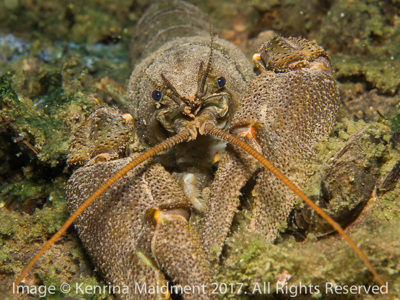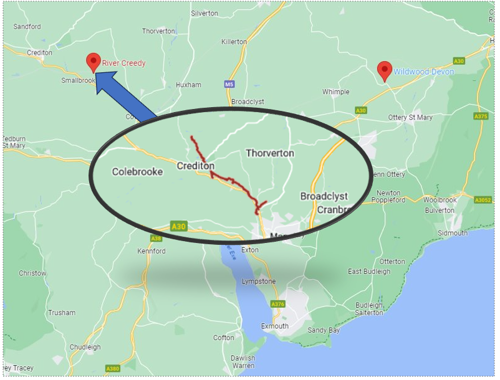
Why are white-clawed crayfish endangered?
1st Aug 2023
Authored by Hannah Thomas - a conservationist and Wildwood Devon volunteer based in Somerset.
White-clawed crayfish - small, freshwater crustaceans - are related to lobsters and have been around for over 30 million years. You may be most familiar with American (signal) crayfish as a posh sandwich filling but you may not have been aware that we have our own smaller version here in the UK.
Once widespread in English streams and rivers, the White-clawed crayfish is now recognized as globally endangered (IUCN) and is close to extinction in Devon. It would be unwise (and unlawful) to catch any you might be lucky enough to see nowadays however as the species is protected under the Wildlife and Countryside Act 1981.
What benefits do white-clawed crayfish bring?
Most crayfish are considered keystone species in their native environment. This term is used to cover species that support healthy habitats and ecosystems through their feeding habits. In the wild, crayfish eat a wide range of foods including invertebrates (e.g. other water ‘bug life’, even each other!), plants and fragments of detritus. They are excellent at recycling the nutrients in their habitats, keeping the water clean and bringing the oxygenated water into the sediment.
Where might you find crayfish ?
The secretive behaviour of white-clawed crayfish is one reason why so few people have seen them. They usually only forage for food during the hours of darkness and like to hide under boulders, tree roots and undercut banks. The loss of over 70% of their population in the south west in the last 50 years is sadly another.
Historical records indicate crayfish were once present in many Devon rivers. Sadly, there are only two known wild populations remaining in Devon - one in the River Culm and another in the River Creedy Yeo. Both of these are under threat of extinction.
Throughout its range the white-clawed crayfish is classified as endangered, with these declines largely attributed to human activities.
- We have altered their rivers by adding dams, preventing migration of the species, or by removing the necessary shelters when waterways are dredged or straightened.
- Changing land management regimes, such as logging and agriculture has introduced more sediment which affects crayfish by blocking their gills and preventing adequate oxygen supply.
- Increasingly polluted waters - crayfish are sensitive to pollutants, including pesticides, that can enter rivers. Fluoride-containing pesticides can prevent them from feeding.
- Invasive species - crayfish farming in the 1970s led to deliberate or accidental introduction of non-native crayfish to watercourses. Resulting in predation, competition and spread of disease. The most prolific being the signal crayfish which carries a fungal infection known as the crayfish plague and is lethal to white-clawed crayfish which have no natural immunity.
Why are signal crayfish in the UK bad news?
Signal crayfish not only carry a deadly crayfish virus which kills white-clawed crayfish but they also prey and outcompete for food. White-clawed crayfish are a smaller, less aggressive species which produce fewer young. Signal crayfish produce greater numbers of young and mature faster. Unlike our native crayfish species, signal crayfish burrow extensively into river banks and predate coarse fish and eggs, which means that there is also a risk of soil erosion, flooding and deterioration of ecosystem health if they are present. Their burrowing in riverbanks also harms the economy - affecting flooding, livestock safety and river-side structures – alongside predation on fish eggs reducing fish-stocks.
Although the species is found throughout Europe, it is estimated that almost a quarter of the total population lives in the UK. The UK therefore has an obligation not just morally but also legally to try to protect and conserve the species wherever it occurs.
Wildwood Devon’s crayfish hatchery & nursery
We are delighted to have been awarded £10,452 by the Devon Environment Foundation (DEF) to establish a crayfish hatchery and nursery at Wildwood Devon.
The first project of its kind undertaken at Wildwood, the charity has been working with partners including conservationist and crayfish specialist Jen Nightingale to ensure conditions in the hatchery are right for captive rearing and breeding.
Our hatchery aims to restore population numbers and eliminate the threat of extinction and will provide a refuge for female crayfish carrying eggs - also known as berried females due to the way they carry their eggs on the underside of their abdomen, which look like berries.
Hatchlings will be raised at Wildwood Devon for a couple of years, before being released into protected areas called Ark sites or back into the River Creedy Yeo and monitored as part of the Creedy Catchment Crayfish project. It is expected that their release will help restore the Creedy catchment and improve water quality, species diversity and ecosystem health.

We are currently in phase 1 having undertaken captive rearing of wild-caught berried females into the hatchery. So far so good as at the time of writing this we have 10 white-clawed crayfish hatchlings!
We will be seeking further funding shortly to move into our planned later phases which involves captive breeding; i.e., selecting wild-caught adult brood-stock, (in early autumn), which we will mate in captivity and the females will incubate the eggs from autumn through to spring at the hatchery. The Devon white-clawed crayfish population has low numbers remaining in the wild and therefore there is uncertainty as to how many berried females we may be able to capture for this initial pilot phase so our target number of 500 hatchlings may be reduced.
Longer-term we are planning on carrying out both captive breeding and captive rearing in the white-clawed crayfish hatchery. Employing both techniques will reduce our dependency for reintroduction on wild-caught berried females to produce the hatchlings. This stage of the project, which will also require extra funding, will ensure that we can produce enough captive born and bred white-clawed crayfish for sustainable, viable ark sites and supplementations.
The hatchlings will be reared on for release into safe aquatic ark sites in Devon and may be used to supplement headwaters of river catchments. Thanks to Bradshaws Direct, we have been able to set up several tanks ready to welcome new white-clawed crayfish additions.
The white-clawed crayfish hatchery and nursery is part of the Creedy Catchment Crayfish project to restore the Creedy catchment and improve water quality, species diversity and ecosystem health.
What can you do to help?
You can help limit the transfer of crayfish plague, which devastates populations of white-clawed crayfish and is easily transferred between watercourses on wellies, fishing equipment or even by your dog!. The microscopic spores can survive out of water for 48 hours and if in wet or muddy items it can survive for up to 3 weeks. When you or your pets have been in the water remember to follow the CLEAN-CHECK-DRY set of principles. This link will tell you more about what to do www.nonnativespecies.org/checkcleandry/
Under the Wildlife and Countryside Act 1981 (as amended), it is an offence to release, or allow to escape, any non-native species into the wild in the UK except under licence. If you catch a signal crayfish, bring it ashore or into the boat for humane destruction.
As we will be looking for further funding to support this much needed project of re-introduction for the White-clawed crayfish, if you would like to support us by making a donation you can do so here all contributions however small will make a real difference allowing us to help local wildlife in Devon.
